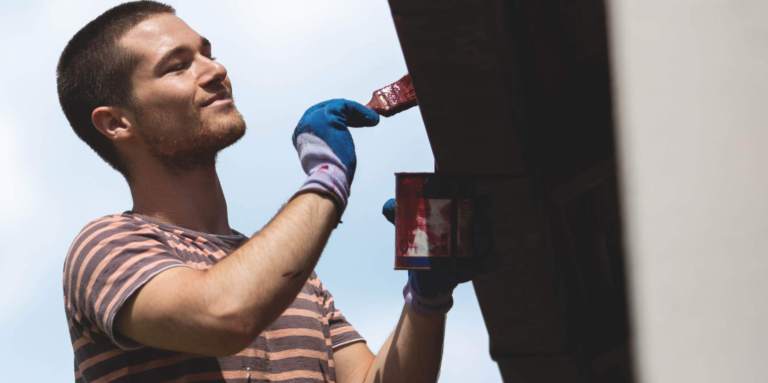Insurance does cover specific water damage that occurs because of a problem with gutters. However, this is a bit of a sticky issue and depends on the type of Homeowners Insurance you have.
When does Homeowners Insurance cover water damage?
A standard homeowners policy covers water damage only if it is sudden and internal. It is required that the water has never touched the outside ground. The water damage must result from sudden and accidental tearing, cracking, burning, or bulging of steam, heating, AC, or automatic fire protection system.
So, if a pipe bursts from a sudden freeze or an appliance or fixture overflows (toilet, washing machine, bathtub), your policy should cover the damage. Homeowners’ insurance exclusions also differ between companies and from state to state.
When does homeowners’ insurance not cover water damage?
Homeowner’s insurance will not cover neglect or failure to make repairs, wear and tear, corrosion and rust, contamination, animals and pests, fungi, nuclear hazards, power failure, government actions, and war.
The most critical issue to take note of is flooding. This is a common peril in some areas, and insurance is explicitly designed for this, so you need to buy separate coverage for flooding. You should be informed when you purchase your home if your home is in a flood zone. You will be required to buy flood insurance in this case. However, if you don’t live in a flood-designated zone and your sewer backs up or have a flood in your basement, you probably will have to bear the costs of the damage yourself.
Gutters and Your Insurance
Gutters fall within an unusual band of coverage. If your gutters overflow and cause water damage to your foundation, it will likely be considered neglect because you should maintain your gutters and ensure they are clean and unclogged. So, this would not be covered.
If a tree falls on your home and knocks the gutter off it so it cannot contain the water and you end up with a leaky roof, this would likely be covered. However, it would be covered for the roof repair (only where the tree caused damage), the interior attic or room repair where water leaked in, and the gutter replacement. But if you fail to contact your insurance company immediately and make the repairs, if basement flooding happens due to the gutters being knocked off the house, you probably won’t be covered for the basement portion of the event.
Mold is covered by your insurance if caused by a sudden and internal incident. Again, a burst pipe or an overflow of an appliance that causes mold growth would be covered. But mold growth caused by a backed-up gutter that leaks into your attic and causes mold damage would not be covered. When mold is covered, it is generally limited to a certain amount, so check your policy to see how much would be covered. The average seems to run around $5000 in damage, but this changes depending on your policy and state.
How to file a claim after water damage
Once you can determine if your policy would cover water damage, contact your insurer as soon as possible. Take photos of the impacted areas, especially if you will be making the repairs, before the adjuster can come out to inspect your home. You can even get estimates from contractors before the adjuster comes out so that you have an idea of the repair costs.
Once the adjuster comes and inspects your home, they can make a better determination on the damage and what will be covered. If you received estimates from contractors, you might be able to negotiate with the adjuster based on the costs of the estimates.
Once you agree with the adjuster, the insurance company will generally send you a check for half up-front to begin your repairs. The remaining payment will be made upon completion, minus any deductible you owe. The deductible is the out-of-pocket cost you must pay before the insurance company begins to pay your claim. The higher your deductible, the lower your insurance premium will be.
Prevent water damage with Leaf Guard
Eight out of 10 incidents to go wrong with a home today has to do with water-related damage. Clogged gutters can cause water damage to your roof, siding, fascia, foundation, and landscaping. Leafguard’s proprietary clog-free design eliminates water damage to your home caused by clogged gutters.
All gutters carry water away from your home, but only Leafguard does it with a unique, proprietary one-piece debris-shedding design that is better than any other gutter system on the market today. Leafguard gutters work on a simple but powerful scientific principle known as liquid adhesion. This allows rainwater to travel around the hood and into the gutter while deflecting leaves and other debris, never clogging.
Other gutter systems are multi-piece with seams vulnerable to leaks, rust, and sag. Leafguard’s seamless one-piece design has no gaps or seams for water to leak through and won’t pull away or sag, guaranteed.
Leafguard’s proprietary design keeps leaves, pine needles, fir needles, and debris out of your gutters. This is covered under our lifetime clog-free guarantee*, so you never have to worry about the hassle of clogged gutters again. And you won’t have to worry about trying to file an insurance claim for damage caused by your gutters. That’s why we say Leafguard – Get it. And forget it.
*Guaranteed not to clog for as long as you own your home, or we will clean your gutters for free.


